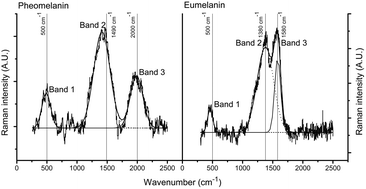Pheomelanin molecular vibration is associated with mitochondrial ROS production in melanocytes and systemic oxidative stress and damage†
Abstract
Vibrations in covalent bonds affect electron delocalization within molecules, as reported in polymers. If synthesized by living cells, the electron delocalization of polymers affects the stabilization of cellular free radicals, but biomolecular vibration has never been considered a potential source of cytotoxicity. Here we show that the vibrational characteristics of natural pheomelanin and eumelanin contribute to feather color expression in four poultry breeds with different melanin-based pigmentation patterns, but only the vibrational characteristics of pheomelanin are related to the production of reactive oxygen species (ROS) in the mitochondria of melanocytes and to systemic levels of cellular oxidative stress and damage. This association may be explained by the close physical contact existing between mitochondria and melanosomes, and reveals an unprecedented factor affecting the viability of organisms through their pigmentation. These findings open a new avenue for understanding the mechanism linking pheomelanin synthesis to human melanoma risk.



 Please wait while we load your content...
Please wait while we load your content...